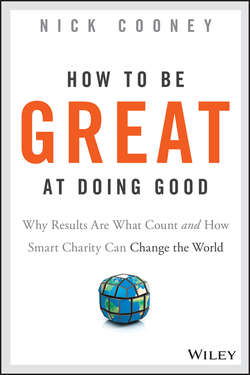Читать книгу How To Be Great At Doing Good - Cooney Nick - Страница 7
1
Why Charity?
Barriers to Good
ОглавлениеThat is, of course, a phenomenal goal. We should appreciate how wonderful it is that we have an impulse to help those in need. But despite our good intentions, we are not always as effective as we could be at reaching that goal. Blind spots, bad advice, personal biases, and other barriers are all around us, conspiring to prevent us from going very far toward making the world a better place.
Many books, magazine articles, and newspaper columns have been written about ostensibly charitable efforts gone terribly wrong. Sometimes these involve charities carrying out programs that do more harm than good, such as the World Wildlife Fund promoting legislation that could lead hundreds of thousands of animals to be lethally poisoned. Sometimes, charities squander vast sums of money, such as Yele Haiti, the Haitian relief organization founded by musician Wyclef Jean, which spent huge sums on celebrity plane tickets, personal payouts, and unfinished projects. Sometimes, organizations spend exorbitant amounts on overhead, such as the Cancer Fund of America, which spends over 80 percent of its income on fundraising.
Exposing bad apples like these is critically important, and we should tip our hats to anyone who does so. But that's not what this book is about. Because, as incompetent, counterproductive, or even criminal as some charities may be, our biggest barrier to doing good is not that we might be duped by a few bad organizations.
The biggest barrier is the set of mistakes that all of us make in our everyday charitable decisions. It is the critical flaws in approach and reasoning that plague even the most highly respected non-profits. It is the biases and lack of rigor that prevent us from accomplishing anything close to the amount of good we have the potential to accomplish.
Those missteps seem to stem from two main causes. The first is the fact that, as with many things in life, our perceived motivations as donors, volunteers, and non-profit workers are often quite different from our actual motivations. Our decisions are mainly driven by the crystal-clear objective embedded into our DNA over millions of years: look out for number one. Even when carrying out charitable work, our primary reward systems and concerns are often centered on ourselves.
The second reason our charitable efforts fall short of their potential is that we are taught charity is a warm, fuzzy thing and that as long as our intentions are good we should be applauded. We are not taught to think rigorously about our approach. We are not taught how to succeed at doing good, or even that success is what matters. So we aren't in the habit of making calculated decisions when it comes to doing good.
Over the course of this book, we'll take a closer look at what's holding us back in our efforts to make the world a better place. We'll learn how we can go around those barriers and make smarter charity decisions.
In Chapter Two we'll look at the difference between doing good and doing great. Instead of simply asking whether a certain charitable effort does good, we'll introduce a second question: How much good does it do?
In Chapter Three we'll examine, in the words of famed business author Jim Collins, the “brutal facts” about the relative impact that different charities and different charitable programs have on the world. Accepting these facts and allowing them to guide our charitable decisions is one of the most potent things we can do to achieve more good.
In Chapter Four we'll discuss how most non-profits – and most of us as individual donors or volunteers – fail to set a “bottom line” for our work. Setting a bottom line can bring increased focus to our charity work and enable us to do more.
In Chapter Five we'll talk about the importance of efficiency, or doing the most good for the least amount of money. For donors and non-profit staffers alike, efficiency is everything if we want to change the world.
In Chapter Six we'll consider why the amount of money a non-profit receives has virtually no relationship to how much good it does. We'll look at how we as donors can incentivize non-profits to become great and the barriers we face in trying to make smart donor decisions.
In Chapter Seven we'll discuss some of the ways in which our brains seem to hardwire us to make poor charity choices. We'll identify the biases that threaten to steer us off course and show how we can outsmart our brains and achieve our charitable goals.
In Chapter Eight we'll put the advice we've been given about charity our whole lives under the microscope. Being able to identify and weed out advice that sounds good but isn't true can help pave the way for intelligent charity decisions.
In Chapter Nine we'll explore our unwillingness to admit what we don't know, and our tendency to let assumptions guide our charity decisions. Testing those assumptions can help non-profits become a lot more successful.
In Chapter Ten, the final chapter, we'll review how to be great at doing good. We'll outline nine steps for making smart charity decisions and empowering ourselves to do far more good with the time, money, and energy that each of us has.
